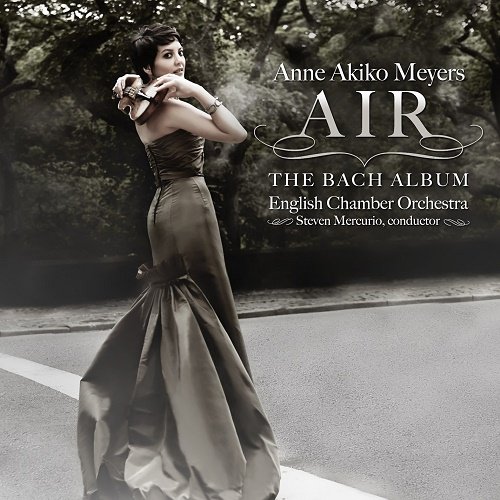Anne Akiko Meyers, English Chamber Orchestra & Steven Mercurio - Air: The Bach Album (2012) Hi-Res

Artist: Anne Akiko Meyers, English Chamber Orchestra & Steven Mercurio
Title: Air: The Bach Album
Year Of Release: 2012
Label: eOne Music
Genre: Classical
Quality: FLAC (tracks 24bit/96kHz) d.booklet
Total Time: 57:29
Total Size: 1.11 Gb
WebSite: Album Preview
Tracklist: Title: Air: The Bach Album
Year Of Release: 2012
Label: eOne Music
Genre: Classical
Quality: FLAC (tracks 24bit/96kHz) d.booklet
Total Time: 57:29
Total Size: 1.11 Gb
WebSite: Album Preview
01. 'Air' from Orchestral Suite No. 3 in D major, BWV 1068 5:12
02. Violin Concerto No. 1 in A minor, BWV 1041 (i. Allegro moderato) 3:35
03. Violin Concerto No. 1 in A minor, BWV 1041 (ii. Andante) 6:20
04. Violin Concerto No. 1 in A minor, BWV 1041 (iii. Allegro assai) 3:28
05. Violin Concerto No. 2 in E major, BWV 1042 (i. Allegro) 7:34
06. Violin Concerto No. 2 in E major, BWV 1042 (ii. Adagio) 6:41
07. Violin Concerto No. 2 in E major, BWV 1042 (iii. Allegro assai) 2:43
08. 'Largo' from Concerto for Harpsichord in F minor, BWV 1056 3:17
09. Concerto for 2 Violins, Strings and Continuo in D minor, BWV 1043 (i. Vivace) 3:38
10. Concerto for 2 Violins, Strings and Continuo in D minor, BWV 1043 (ii. Largo ma non tanto) 6:16
11. Concerto for 2 Violins, Strings and Continuo in D minor, BWV 1043 (iii. Allegro) 4:39
12. Ave Maria 4:05
Meyers retains the Largo from the Harpsichord Concerto, BWV 1056 in the original key, a step lower than the popular arrangement of the work for violin, before launching into a brisk reading of the Double Concerto. The notes emphasize the uniqueness of her playing the concerto’s two parts on two different violins: Stradivaris from 1697 (Molitor) and 1730 (Spanish). Jascha Heifetz also played both parts in his recording from 1946 of the piece (later he played it with his student Erick Friedman), a gesture that struck some at the time as a sort of stunt. Meyers (or the violins she plays) manages to keep the parts tonally separate in the first movement, where it’s perhaps harder, as well as in the second movement, where it’s perhaps easier. For those who believe that there’s little really discernible difference (stories abound about Fritz Kreisler fooling his listeners into believing that his Stradivari sounded particularly good when in fact he’d been playing his Vuillaume) might want to reconsider after listening to Meyers’s performance. In the slow movement, in particular, Meyers’s clean articulation in both parts keeps the music from buckling under a crushing weight of solemnity, while her reading of the finale bustles with kinetic energy. The program concludes with a reading of Charles Gounod’s counterpoint to Bach’s First Prelude from Book 1 of the Well-Tempered Clavier. Perhaps this chestnut has to be played with a certain romantic lushness, and that’s the way Meyers does it.
Maybe it’s crossover (the photographs almost suggest that), but for those who can tolerate Meyers’s (and the engineers’) premises, her conclusions (and theirs) should be highly palatable. Recommended to those listeners—but more generally, too, for the ingenious interweaving of the two violins Meyers has effected in the Double Concerto; pairs of soloists, not so well matched, often achieve much less.
Maybe it’s crossover (the photographs almost suggest that), but for those who can tolerate Meyers’s (and the engineers’) premises, her conclusions (and theirs) should be highly palatable. Recommended to those listeners—but more generally, too, for the ingenious interweaving of the two violins Meyers has effected in the Double Concerto; pairs of soloists, not so well matched, often achieve much less.
download 24bit
ISRACLOUD
ISRACLOUD
![Eshon Burgundy - Safe Place (Bossa Nova Jazz) (2025) [Hi-Res] Eshon Burgundy - Safe Place (Bossa Nova Jazz) (2025) [Hi-Res]](https://www.dibpic.com/uploads/posts/2025-12/1766079194_cover.jpg)

![Betty Carter - The Music Never Stops (2019) [Hi-Res] Betty Carter - The Music Never Stops (2019) [Hi-Res]](https://www.dibpic.com/uploads/posts/2025-12/1765896843_bcmn500.jpg)

![Ready Player 3 - Ready Player 3 (2025) [Hi-Res] Ready Player 3 - Ready Player 3 (2025) [Hi-Res]](https://www.dibpic.com/uploads/posts/2025-12/1766128773_cover.jpg)



